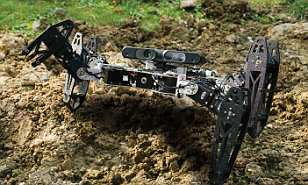
While it’s a common fear that robots will one day rise up and turn against us, there’s currently a major obstacle standing in the way – they’re too fragile.
New research is hoping to make robots more resilient by equipping them with special software that can help them learn how to bounce back from an injury in two minutes or less.
The hope is that these learning algorithms will help produce more effective autonomous robots that require less human intervention and can last longer in critical situations like the workplace or search and rescue scenarios.

A team of scientists equipped robots with special software that can help them learn how to bounce back from injuries in two minutes or less, by taking a page from real animals.
For the study, scientists from the Pierre and Marie Curie University and the University of Wyoming, took a page from real animals.
When an animal is injured, they’re able to compensate by limping, shifting their weight or some other strategy.
Many three-legged dogs can catch Frisbee, for example, or if someone sprains their ankle, they can still figure out how to walk even with an injury.
‘When injured, animals do not start learning from scratch,’ Jean-Baptiste Mouret, a co-author of the study, said in a statement.
‘Instead, they have intuitions about different ways to behave.
‘These intuitions allow them to intelligently select a few, different behaviors to try out, and after these tests, they choose one that works in spite of the injury.
‘We made robots that can do the same,’ he explained.

Before the robot is deployed, it uses a novel algorithm to create a detailed map of the space. This allows it to develop certain intuitions about what behaviors it can perform and their value
Before the robot is deployed, it uses a novel algorithm to create a detailed map of the space.
According to the researchers, this map represents the robot’s ‘intuitions’ about what behaviors it can perform and their corresponding value.
Essentially, the robot can build a library of different motions and establish which body parts it can rely on if it becomes injured, even if it has a broken or missing leg.
Requiring a robot to map all these scenarios would take too long and could potentially damage the device, so the scientists mapped them out in a computer simulation.
In doing so, they were able to test and map over 13,000 different ways of walking, including with ‘damaged, broken and missing legs, and for a robotic arm with joints broken in 14 different ways’, according to the study.
The scientists call this process an ‘intelligent trial and error algorithm,’ ultimately enabling the robots to adapt to situations in two minutes or less.

With this study, the researchers are hoping that it will give robots greater longevity in dangerous or time sensitive situations, i.e. rescuing people from forest fires or earthquakes
After it becomes damaged, the robot acts like a ‘scientist’, trying out different behaviors and ruling out those that don’t work.
‘We have robots store knowledge from previous experience in the form of a map of the behavior-performance space,’ the researchers noted.
‘Guided by this map, a damaged robot tries different types of behaviors that are predicted to perform well and, as tests are conducted, updates its estimates of the performance of those types of behaviors’
‘The process ends when the robot predicts that the most effective behavior has already been discovered. The result is a robot that quickly discovers a way to compensate for damage without a detailed mechanistic understanding of its cause, as occurs with animals,’ they concluded.
In the past, scientists have been able to develop self-diagnosing robots, but they used expensive sensors that often took a while to develop a contingency plan (such as walking with a limp).
COULD THIS TINY ROBOT SOME DAY BE USED TO DELIVER DRUGS INSIDE OUR BODIES?
Scientists at Germany’s Max Planck Institute for Intelligent Systems have developed a tiny robot that might be able to be used for medicinal purposes.
The robot is about a seventh of an inch long, making it smaller than a penny.
Called a ‘millirobot,’ it can walk, crawl and jump on land, as well as swim in water.
Scientists modeled it after creatures like jellyfish, caterpillars and larva.
Without any legs, the robot is made of a soft, pliable rubber that’s embedded with magnets
The robot is controlled using a magnetic field
The team hopes that the soft robot can be inserted in human bodies for targeted drug delivery
It may also be used to improve minimally invasive surgical procedures.
The scientists could add a pocket to the tiny robot that can house drugs.
With this study, the researchers are hoping that it will give robots greater longevity in dangerous or time sensitive situations.
For example, self-repairing robots would be able to wade into situations deemed too dangerous for humans, such as forest fires, retrieving trapped victims or shutting down a nuclear plant.
‘It could enable the creation of robots that can help rescuers without requiring their continuous attention,’ Danesh Tarapore, a co-author of the study, said in a statement.
‘It also makes easier the creation of personal robotic assistants that can continue to be helpful even when a part is broken.’
Do you have a hot story or scandal you would like us to publish, please reach us through toktok9ja@gmail.com or WhatsApp: +2348033498347
ATTENTION! ATTENTION!! ATTENTION!!! ADVERTISE ON TOKTOK9JA AND REACH OUT TO YOUR DESIRED AUDIENCE: HERE


























Gosh, I wish I would have had that inrftmaoion earlier!